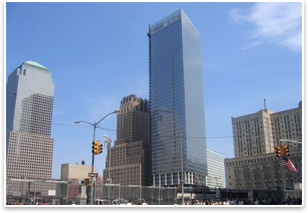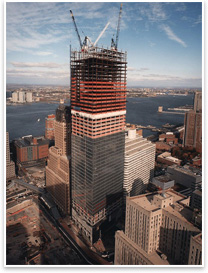New High-Rise Concepts Inspired by 9/11 Under Debate
Can examination of a terrorist attack make safer buildings overall?
by Zach Mortice
Assistant Editor
Summary: Six years after the events of 9/11 unimaginably changed how everyone thinks about building safety, threats and solutions real and imagined have generated a number of new ways to think about tall-building performance. Not surprisingly, one of the first places these new changes have been manifested is right on Ground Zero—at Skidmore Owings and Merrill’s 7 World Trade Center, across the street from the site of the original towers.
 SOM, working with structural engineer WSP Cantor Seinuk, designed the 52-story, 741-foot-tall building (taller than its predecessor) as one of the first buildings in the world designed to prevent progressive collapse due to an extreme event, according to Cantor Seinuk CEO Silvian Marcus, PE. The concrete used for the rapid construction of the lower levels of the building that house a Con Edison sub-station also serves as a strong base to protect against possible ground-based explosions, The building also features a reinforced concrete core built with walls over 2 feet thick encasing exit stairs, elevators, and utilities infrastructure for the full height of the building. Steel framing on the 42 levels above the substation offers a 45-foot column-free office space. This design solution creates a redundant structure, with perimeter spandrel beams employed as a rigid moment frame to support the structure's weight, should one or more columns be damaged. SOM, working with structural engineer WSP Cantor Seinuk, designed the 52-story, 741-foot-tall building (taller than its predecessor) as one of the first buildings in the world designed to prevent progressive collapse due to an extreme event, according to Cantor Seinuk CEO Silvian Marcus, PE. The concrete used for the rapid construction of the lower levels of the building that house a Con Edison sub-station also serves as a strong base to protect against possible ground-based explosions, The building also features a reinforced concrete core built with walls over 2 feet thick encasing exit stairs, elevators, and utilities infrastructure for the full height of the building. Steel framing on the 42 levels above the substation offers a 45-foot column-free office space. This design solution creates a redundant structure, with perimeter spandrel beams employed as a rigid moment frame to support the structure's weight, should one or more columns be damaged.
Further safety enhancements include:
- Exit stairs 20 percent wider than required by code
- Twice the required water storage capacity for the sprinkler system
- Pressurized ventilation to filter out air contaminants in paths of egress
- Fireproofing material for the steel structure to be more than five times as durable as code requirements
- Redundant ground level exits
- Emergency generators and a back-up emergency command center.
Three overarching strategies
These design-strategy changes in part reflect the findings of a three-year study of the WTC disaster by the National Institute of Standards and Technology (NIST). This study (which evaluated and made recommendations based on the failure of several structures other than the WTC towers) is being used by code advocacy groups, such as the Ad Hoc Committee for Terrorism Resistant Buildings and the Code Technology Committee, to support their lobbying for changes in the International Code Council International Building Code (ICC IBC).
This most recent round of changes is included in the 2007 IBC supplemental. Over the next 18 months, an ICC committee of code officials, architects, engineers, and other design professionals will convene twice to hear testimony from experts and finalize the 2009 edition’s code changes.
Released early in the summer of 2007, the supplemental’s security changes for how fireproofing is tested in the field deal with three primary areas:
- Enhancing the fire resistance of building frames
- Improving fireproofing systems
- Requiring additional evacuation-system elements and capacity, such as including luminous markings that indicate exit paths, requiring a minimum of one fire service access elevator, and adding an extra stairway for buildings over 420 feet in height.
But how much can any building do?
The AIA has requested further consideration concerning this last specification. David Collins, FAIA—who will testify at ICC hearings in 2008, including testimony on 12 code changes on behalf of the AIA—calls the third stairway requirement “irrational and unnecessary … We don’t have any evidence that two stairs are inadequate, particularly now that we have a mandated fire access elevator,” he says.
Believing that more research from NIST on building performance during catastrophic fires is a priority, Collins is reluctant to draw too many conclusions from the NIST study related to 9/11. “The NIST study concluded that the building failed because it was struck by an airplane,” says Collins. “We do not design buildings with the intent to prevent their collapse if hit by an airplane. Everything else in the report is superfluous.”
Building security expert Thomas Vonier, FAIA, is also skeptical of how much engineering and architecture can do to prevent the kind of destruction seen in the 9/11 attacks. “I just don’t see how architects and engineers can design buildings that are intended for civilian use that can withstand that kind of attack,” he says. “I think the most you can hope for is to prevent progressive collapse.”
 Debate on progressive collapse Debate on progressive collapse
Drawing conclusions on progressive collapse from the NIST report on the WTC disaster is dubious at best, according to code experts, because that was a total structural failure, not a progressive collapse. The confusion in definition is easy to understand, especially in the public mind. The WTC towers’ collapse involved the rapid tilting and rotation of the building, in a manner FEMA investigators called a “progressive series of failures.” A progressive collapse, on the other hand, occurs when one structural element fails and then causes a chain reaction of failure that leads to the partial or complete destruction of a building. (It was progressive collapse that attackers tried unsuccessfully to initiate when they parked an explosives-laden truck near a column base in 1993. That attack prompted the N.Y./N.J. Port Authority to install emergency lighting in the stairwells, incidentally, which some claim saved lives on 9/11.)
The attack by jetliners is what makes the WTC tragedy incomparable to a progressive-collapse scenario. It was that impact that dislodged fireproofing insulation from the buildings’ frame, allowing fire from the planes’ jet fuel to heat the steel, which then lost its strength and rigidity. As the exposed steel got hotter and weaker, the columns were compromised and eventually gave way under the weight of the undamaged floors above the impact, collapsing floor by floor. As the AIA’s response to the NIST study says, even the impact of a 767 jetliner did not by itself compromise the initial load-bearing capacity of the buildings.
An alternative approach
Nevertheless, progressive collapse remains a concern for some, so prevention of high-rise building collapse still will be debated at the ICC’s next set of hearings in February and March of 2008. Advocacy groups, including the Ad Hoc Committee for Terrorism Resistant Buildings and the Code Technology Committee and the National Council of Structural Engineering Associates (NCSEA) have introduced code changes they contend will enhance structural integrity. These changes are meant to boost general structural continuity and resistance against natural disasters for all buildings by strengthening structural connection points to make them as strong as the beams and columns they connect.
In addition, the NCSEA is working on code changes that will apply only to buildings deemed terrorism security risks. These are likely to be a combination of the structural continuity strategy, providing redundant load paths if structural supports fail, and locally hardening structural elements. Such an approach is described by Shyam Sunder, the lead investigator of the WTC disaster, as the “brute force” way to prevent building collapse.
The issues the NCSEA committee has been working on “are very deliberately described as dealing with structural integrity," says Committee Chair Steven Winkel, FAIA. “The term ‘progressive collapse’ should not be applied to our work.” The committee's work, by definition, he says, “will be about structural integrity; which encompasses disproportionate collapse, robustness, progressive collapse, loading, and resistance issues.”
Arguably, though, it was the attention that the NIST report brought to the topic of building collapse that has brought this issue to the fore in public perception. Some groups have used that attention shift to advantage in making their case for their proposed changes to the model code. Whether the increased cost will bring a concomitant increase in public health, safety, and welfare will be a matter for upcoming discussion at the ICC hearings.
|



